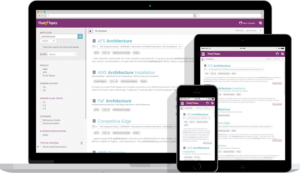We recently sat down with Rolf Schumacher, Head of Technical Documentation at Siemens Building Products to discuss their work with Fluid Topics. Together, they launched a modern content delivery portal that unifies the company’s technical and marketing documentation and optimizes the product experience.
Documentation is a vital part of any product and organization. It plays a key role in the product lifecycle from adoption to maintenance, and reflects the product’s capabilities and quality, as much as the brand image.
In an era of profound digital transformation, technical communication leaders, such as Rolf at Siemens, are turning to Intelligent Content Delivery Platforms to leverage their first-class product documentation and deliver a positive impact on customer-facing services up to their corporation’s innovation standards.
In light of the above, what are the 3 essentials to providing a modern content experience that empowers clients, partners and employees with relevant product knowledge, drives adoption and efficiency, and leads digital transformation?
1. Contextual, Up-to-date Information
Users expect much more than one-size-fits-all manuals and static documentation to download and print, and tediously read through. Modern information search has accustomed them to easy, intuitive access to relevant, up-to-date, and contextual information directly from their most convenient digital channel, app, or tool in use.
This is where smart content delivery capabilities are required to provide an experience-driven solution.
“We create our technical documentation in Schema ST4, then Fluid Topics ingests and transforms our content seamlessly into dynamic, actionable information that is accessible in-context from different touchpoints,“
explained Rolf Schumacher.
A great case in point is software support. Making the software inline help context-sensitive so that it points directly to the information that is relevant to the current user issue and environment is a game-changer for support efficiency and product adoption.
In addition, decoupling the software documentation from the software product itself offers greater flexibility in the delivery and update of one or the other. Documentation can be enriched, updated, and fixed at any time so users always get the freshest, most accurate content, even between product releases.
2. Best-in-Class User Experience
Today’s businesses are highly mobile and many tasks are carried out “in the field,” not in the office, particularly in the area of building technologies. To create an efficient customer experience, reliable product information must be accessible and readable on the user’s preferred device whether that’s a tablet, a mobile phone or a rugged field laptop.

“A PDF on a smartphone is not a true mobile experience,” said Rolf Schumacher, and we couldn’t agree more.
Technical documentation for Siemens Building Products is not only textual but also visual as it embeds images, 2D and 3D vector graphics and videos, and needs perfect rendering while servicing installations. To support field users accurately, Fluid Topics’ Content Delivery technology natively embeds mobile navigation capabilities, provides a responsive interface that adapts to the screen size, and serves multimedia content just as easily as text.
3. Fast Search Technology
Web search engines like Google have set high standards for search performance. Users expect nothing less when they browse your documentation whether it’s for selling, installing a product, maintaining it or dealing with urgent repairs. But we all know that in real-life, finding the right information amid a sea of documents can be a struggle. A global survey by Gartner reported that professionals spend 50% of their time searching for information and take an average of 18 minutes to locate each document.
As a result, the quality of the search tool is essential for technical documentation.
“With Fluid Topics, each technician could save on average 30 minutes per week when searching for appropriate information.“
said Rolf Schumacher.
The Fluid Topics technology leverages advanced ranking algorithms that draw on hundreds of parameters to ensure that everyone find exactly what they are looking for in milliseconds. It offers smart autocomplete, spellchecking, search suggestions, application of business dictionaries, filters which dynamically refine searches, and more. Users are even able to find specific content contained within their repositories, all the way down to the document line-level.
Conclusion
Today, Rolf and his teams publish their content through Fluid Topics. Their clients, partners and employees now enjoy a modern content experience that gives them an online access to consistent and up-to-date product information at the place and moment of need. Watch the following video to discover their Smart Information Delivery Portal.
Latest post





